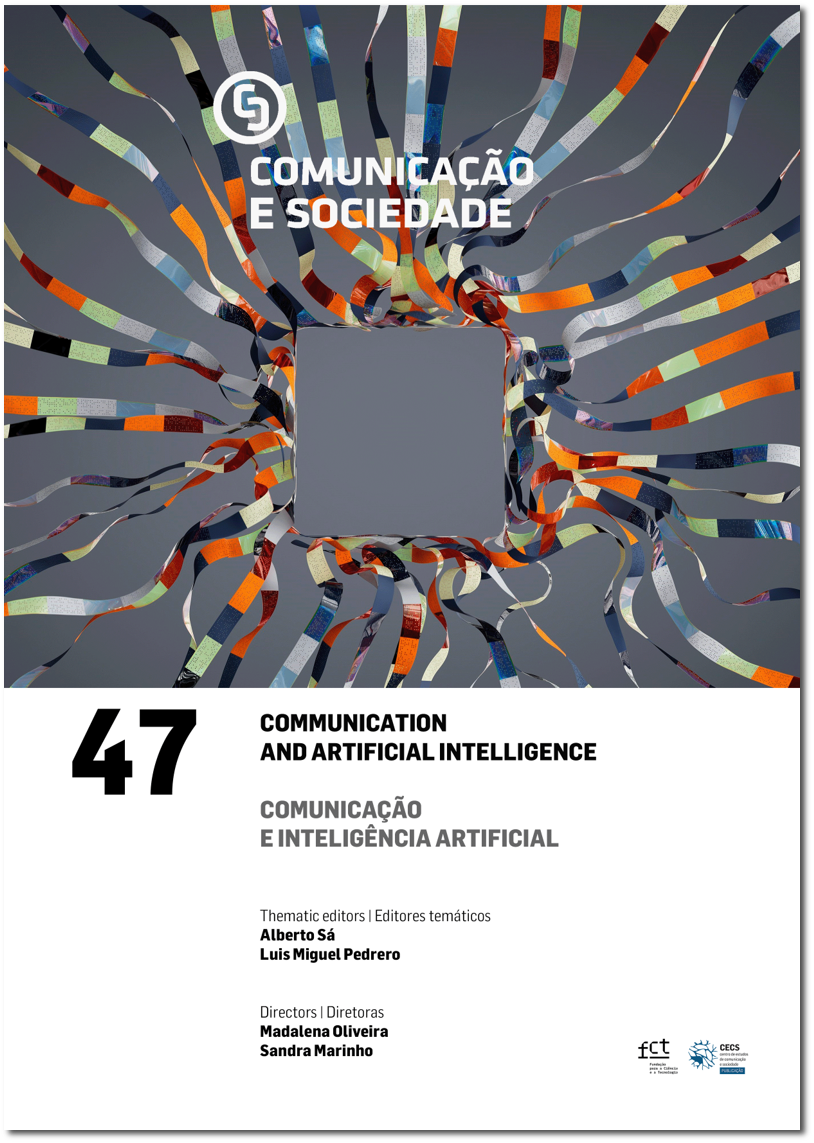Representational Aspects of Artificial Intelligence Generated Images: Semiosis, Self-Referentiality, and Meta-Synthesis
DOI:
https://doi.org/10.17231/comsoc.47(2025).6197Keywords:
self-referentiality, technical images, artificial intelligence, meta-synthetic, semiosisAbstract
This article aims to explore the relationships between the theoretical and conceptual operators of semiosis and self-referentiality, investigating aspects related to the representational dynamics of images generated by artificial intelligence (AI). The work begins with the ambivalent relationship between the image as a criterion of truth and the recognition of its possibilities for manipulation to problematise how emerging aspects of contemporary media logic strain the supposed objectivity of technical images. In this sense, through its own conceptual vocabulary, it aims to characterise synthetic images (generated by AI) as metastases. This proposal is based on an analysis of the representational processes involved in the creation and circulation of AI-generated images, examining the dimensions of prediction, self-referentiality, and meta-synthesis. Thus, the article discusses the specificities of representation and records of reality in technical images, deals with AI-generated images through prediction and their representational status, and characterises them based on the notions of “self-referentiality” and “meta-synthesis” in semiotic networks. In conclusion, the work considers that the imagistic metastases of AI-generated images strain the logical place of representation of the real, which is thus distanced, extended, and traversed by radical mediations and profound mediatisations. Likewise, AI-generated images create self-referential semiosis plots that are statistically predictable and probable, like other previous technical images.
Downloads
References
Baitello, N., Jr. (2012). O pensamento sentado: Dobre glúteos, cadeiras e imagens. Editora Unisinos.
Bazin, A. (2014). O que é o cinema? (E. A. Ribeiro, Trad.). Cosac Naif. (Trabalho original publicado em 1958)
Benjamin, W. (2012). Magia e técnica, arte e política: Ensaios sobre literatura e história da cultura (S. P. Rouanet, Trad.). Brasiliense.
Berry, D. M. (2017). Prolegomenon to a media theory of machine learning: Compute-computing and compute-computed. Media Theory, 1(1), 74–87. https://doi.org/10.70064/mt.v1i1.565
Casadei, E. (2012). Narrativas Mise em Abyme: A instalação de uma competência genérica da reportagem na Revista da Semana (1920-1945). Revista Brasileira de História da Mídia, 1(2), 129–137. https://doi.org/10.26664/issn.2238-5126.1220124022
Crawford, K. (2021). Atlas of AI: Power, politics, and the planetary costs of artificial intelligence. Yale University Press.
De Tienne, A. (2007). Aprendizado e semiose. In J. Queiroz, Â. Loula, & R. Gudwin (Eds.), Computação, cognição, semiose (pp. 67–92). EDUFBA.
De Zeeuw, D., & Geil, A. (2023). This person does not exist: From real generalisation to algorithmic abstraction in photographic portraiture. In D. Forrest & R. Tyszczuk (Eds.), Reconfiguring the portrait (pp. 133–152). Edinburgh University Press. https://doi.org/10.1515/9781399525091-007
D’Ignazio, C., & Klein, L. (2020, 16 de março). Introduction: Why data science needs feminism. Data Feminism. https://data-feminism.mitpress.mit.edu/pub/frfa9szd
Dubois, P. (2004). Máquinas de imagens: Uma questão de linha geral (M. A. Silva, Trad.). In Cinema, vídeo, Godard (pp. 31–67). Cosac Naify.
Flusser, V. (2008). O universo das imagens técnicas: Elogio da superficialidade. Annablume.
Flusser, V. (2011a). Filosofia da caixa preta: Ensaios para uma futura filosofia da fotografia. Annablume. (Trabalho original publicado em 1983)
Flusser, V. (2011b). Pós-história: Vinte instantâneos e um modo de usar. Annablume.
Flusser, V. (2014). Comunicologia: Reflexões sobre o futuro. Martins Fontes.
Gomes, I. (2024, 17 de fevereiro). Por que a inteligência artificial tem tanta dificuldade em desenhar mãos e dedos? Estadão. https://www.estadao.com.br/link/cultura-digital/por-que-a-inteligencia-artificial-tem-tanta-dificuldade-em-desenhar-maos-e-dedos/?srsltid=AfmBOop4XUyHLQvHCZc2fHgOdc8UYvv6lat29ZrLBbtqkaRQSBEoMGGP
Grusin, R. (2015). Radical mediation. Critical Inquiry, 42(1), 124–148. https://doi.org/10.1086/682998
Hepp, A. (2019). Deep mediatization. Routledge.
Ibri, I. A. (2004). Semiótica e pragmatismo: Interfaces teóricas. Cognitio, 5(2), 168–179.
Karras, T., Laine, S., & Aila, T. (2019). A style-based generator architecture for generative adversarial networks. arXiv. https://doi.org/10.48550/arXiv.1812.04948
Machado, A. (1984). Da fotografia à síntese numérica. Revista Imagens: A Imagem Sob o Signo do Novo, (3), 45–60.
Machado, A. (2005). Tecnologia e arte contemporânea: Como politizar o debate. Revista de Estudios Sociales, (22), 71–79. https://doi.org/10.7440/res22.2005.05
Machado, A. (2015). A ilusão especular: Uma teoria da fotografia. Gustavo Gil.
Manovich, L. (2024). Separar e remontar: IA generativa através das lentes das histórias da arte e da mídia. MATRIZes, 18(2), 7–18. https://doi.org/10.11606/issn.1982-8160.v18i2p7-18
Pasquinelli, M., & Joler, V. (2021). The nooscope manifested: AI as instrument of knowledge extractivism. AI & Society, 36, 1263–1280. https://doi.org/10.1007/s00146-020-01097-6
Peirce, C. S. (1931–1958). Collected papers of Charles S. Peirce (Vols. 1–6). Harvard University Press.
Ribeiro, D. M. (2020). Imagens técnicas e o pensamento imagético em Vilém Flusser: Diálogos para uma epistemologia da imaginação. Ação Midiática – Estudos em Comunicação, Sociedade e Cultura, 1(19), 212–234. https://doi.org/10.5380/2238-0701.2019n19-11
Ribeiro, D. M., Alzamora, G., Cortez, N. M. P., & Paes, F. A. O. (2023). O caso Datapovo: Aspectos semióticos e pragmáticos da manipulação de imagens no contexto da desinformação. GALÁxIA, 48, 1–24.
Rogers, R. (2016). O fim do virtual: Os métodos digitais. Lumina, 10(3), 1–34. https://doi.org/10.34019/1981-4070.2016.v10.21353
Santaella, L. (2004). O papel da mudança de hábito no pragmatismo evolucionista de Peirce. Cognitio, 5(1), 75–83.
Silva, T. (2022). Racismo algorítmico: Inteligência artificial e discriminação nas redes digitais. Edições Sesc SP.
The White House [@WhiteHouse]. (2025a, 3 de maio). [Imagem]. X. https://x.com/WhiteHouse/status/1918502592335724809
The White House [@WhiteHouse]. (2025b, 4 de maio). Happy May the 4th to all, including the radical left lunatics who are fighting so hard to to bring Sith Lords, murderers, drug lords, dangerous prisoners, & well known MS-13 gang members, back into our galaxy. you’re not the rebellion—you’re the empire [Imagem]. X. https://x.com/WhiteHouse/status/1918502592335724809
Tunholi, M. (2023, 16 de julho). Por que as inteligências artificiais não sabem fazer mãos? TechTudo. https://www.techtudo.com.br/noticias/2023/07/por-que-as-inteligencias-artificiais-nao-sabem-fazer-maos.ghtml
Downloads
Published
How to Cite
Issue
Section
License
Copyright (c) 2025 Tiago Salgado, Natália Cortez, Daniel Ribeiro

This work is licensed under a Creative Commons Attribution 4.0 International License.
Authors own the copyright, providing the journal with the right of first publication. The work is licensed under a Creative Commons Attribution 4.0 International License.












